FH Series
Vision System
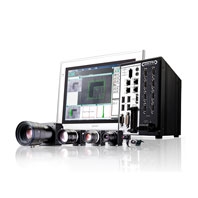
AI-based automated visual inspection
last update: March 1, 2024
AI identifies good products as well as experienced inspectors
Sensory inspection requires a certain tolerance for variations that don't pass a certain threshold.
Determining what variations are acceptable is a key capability of expert inspectors and poses a challenge for automated inspection systems.

The FH Series can determine acceptable variation tolerances.
[AI Fine Matching]
Omron's AI Fine Matching tool learns from the image data of non-defective products to quickly acquire the "expertise" that inspectors develop over the course of many years. This reduces costs and boosts productivity through automation.
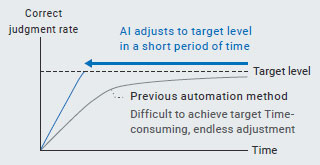
Target inspection level: Reduce overdetection
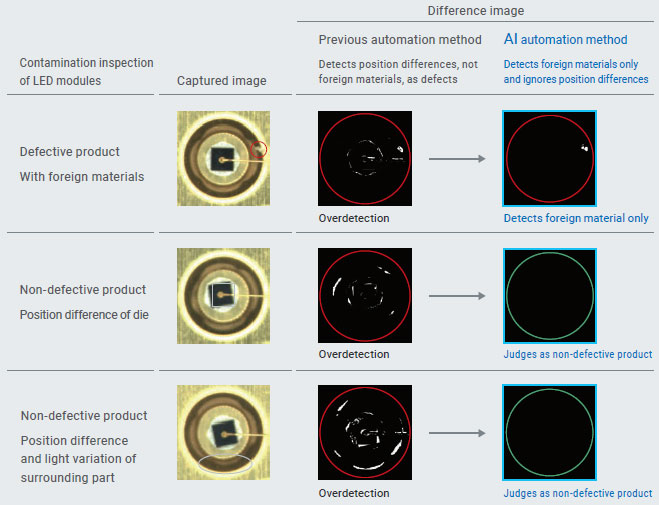
AI Fine Matching
AI reduces overdetection
AI Fine Matching identifies a future that is not included in good products as a defect.
AI learns images of good products with variations, and generates an AI model.
Every time an inspection is carried out, AI reconstructs a model that is presumed to be a good product.
AI extracts a difference between the reconstructed good product image and a captured image to identify a defect, reducing overdetection.
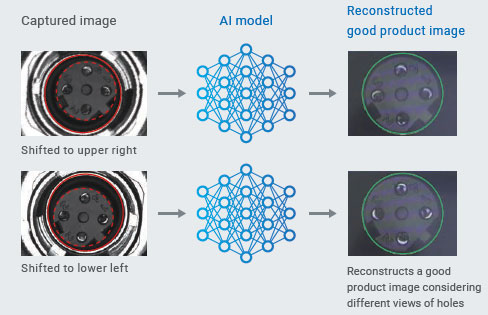
AI makes it easy to avoid overdetection [PATENT PENDING]*1
Three quick steps on the settings screen guide the user through the process of creating the good product model with the minimum number of images.
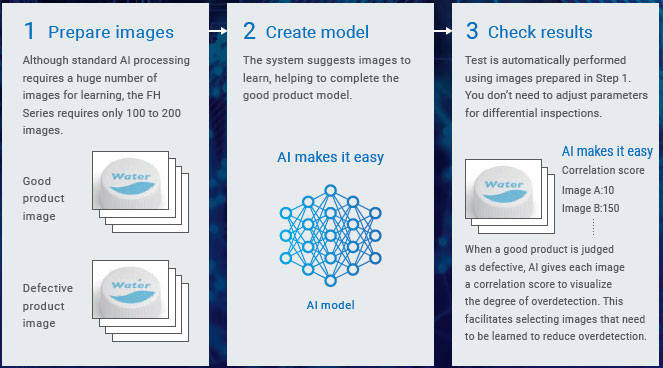
Japan. (as of May 2022)
AI captures defects with human-like sensitivity
Defect detection tasks that rely on human sensibility are a challenge to automate. Fortunately, powerful new AI technology can match the skills and capabilities of experienced inspectors.

Automating human vision-based inspection with the FH Series
[AI Scratch Detect Filter]*1
The latest capabilities of the FH Vision System include a new AI-based image filter that reproduces the technique that skilled inspectors use to identify a defect on any product background. Scratches and blemishes that were once difficult to capture can now be identified even without the use of samples or adjustment.

*1. The FH-UMAI1 Scratch Detect AI Software Installer is required to use AI Scratch Detect Filter.
AI Scratch Detect Filter
AI reproduces human expertise through learned criteria
The AI Scratch Defect Filter learns by means of images in which human inspectors noticed defects.
Whereas previous inspection methods found the unexpected size, shape or color of a particular defect to be a barrier to automation, AI successfully extracts abnormalities by judging their features without definition. The learned data facilitates defect detection on processed surfaces and other uneven backgrounds that previously posed an insurmountable challenge.
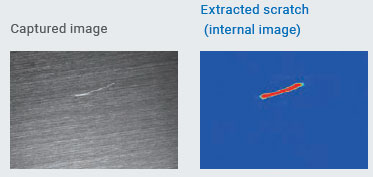
Solutions using AI

Watch use case video.
https://www.fa.omron.co.jp/fh_ai_e
AI identifies good products as well as experienced inspectors
[Issue]
・Uneven colors and dimensional variations within tolerance
・Difficult to identify defects due to complex shapes
・Time-consuming inspection area setting and parameter adjustment for different shapes of many objects
[AI Fine Matching]
・Reliable detection by learning variations in colors and dimensions of good products
・Identification of defects in complex-shaped parts
・Quick setting for many objects with different shapes by simply enclosing inspection areas
Print inspection for product labels
Variations in darkness, thickness, and positions of printed characters are acceptable, and only defects such as chipped characters are detected.
The inspection area is set to the entire label.

Chip and contamination inspection for electronic parts
Minor dimensional differences are permitted, and only defects are detected in complex-shaped parts.
The inspection area is set to the entire part surface.

Contamination and shape inspection for resin molded parts
Efficient learning of many objects with different shapes enables quick setting of conditions for extracting only defects from complex shapes.
The inspection area is set according to the shape of the molded part.

AI captures defects with human-like sensitivity
[Issue]
・Filters and parameters are combined and adjusted to detect low-contrast defects.
・Low-contrast defects cannot be detected.
[AI Scratch Detect Filter]
・Regardless of material type, color, or size, defects can be extracted reliably without previously required definition and adjustment.
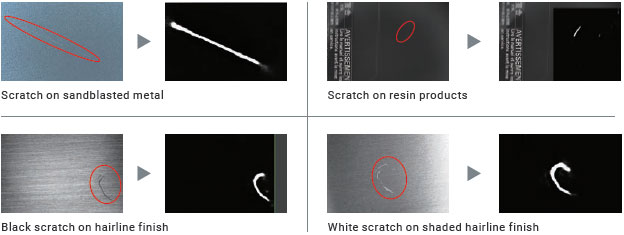
No special environment is required
With the FH Series, there's no need for high-end hardware or specialized engineers who can configure the system to suit your needs. Our general-purpose vision system makes it easier than ever to introduce AI into production sites.
Vision controller with AI functionality
Artificial intelligence has traditionally required a high-end environment, but our lightweight creative solution comes in the form of user-friendly processing items that have been integrated into our popular FH Series hardware.
No special hardware for AI required
It used to be difficult to introduce AI technology to many inspection processes because of its hardware requirements.
The FH Series does not require special hardware, facilitating the introduction of this technology. The FH Series does not require special hardware, facilitating introduction.
No AI engineer required
In order to reliably use AI technology in processes, the engineer used to have not only image processing skills but also programming and maintenance skills. With the FH Series, however, you can use AI technology just like operating a standard vision sensor. No dedicated AI engineer is required.
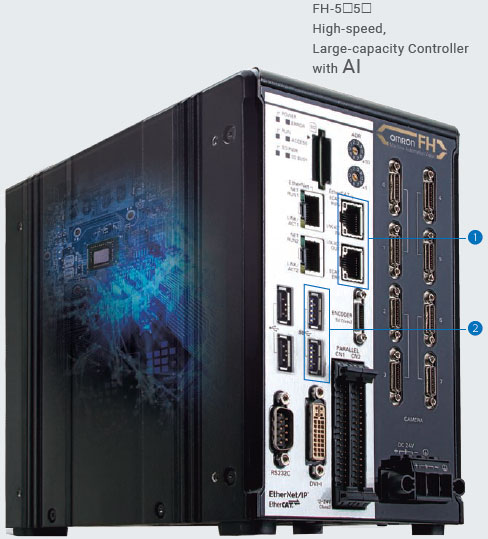
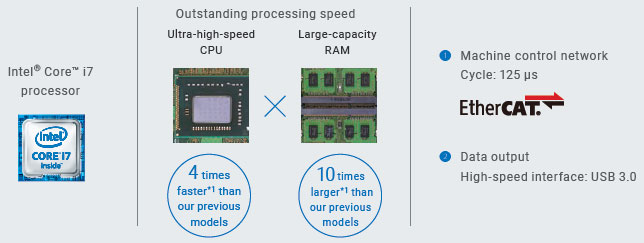
*1. The FH-555[] Controller is compared with the FH-3050 Controller.
High-resolution cameras
We offer a range of cameras that can capture high-resolution images suitable for sensory inspection at high speeds.
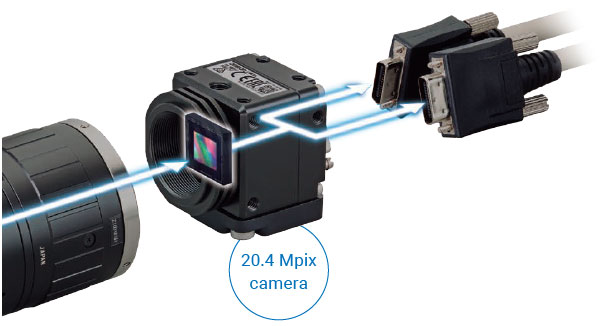
Ultra-high-speed sensing technology in a compact design
There was a trade-off between high-resolution image capture like the human eye and inspection processing speed. We use new CMOS image elements and dual transfer technology to capture high-resolution images while transferring images at high speeds. This facilitates applications that previously required multiple cameras or a mechanism to move a camera.
MDMC light with flexible lighting patterns
This light can be adjusted to defects by combining the illumination colors and angles like humans do.
Even if new objects or inspection items are added after installation, there is no need to add or change the light—just change the illumination pattern.
The illumination patterns can be registered as settings, facilitating duplicating production lines.
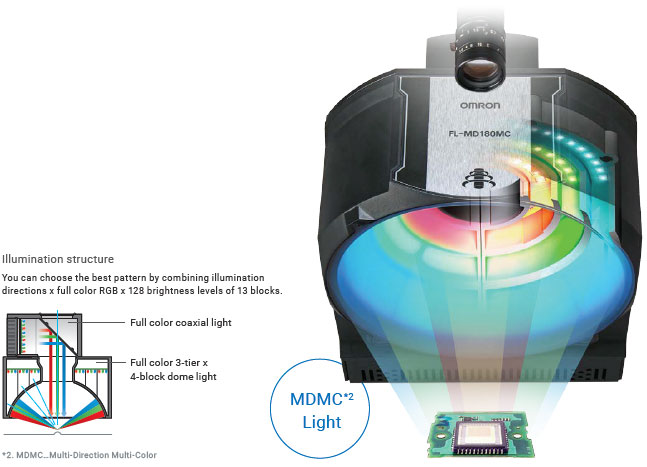
Software for flexible automation
Flexible image capture
Multi-Trigger Imaging captures long objects at high speeds
The Multi-Trigger Imaging function can capture images and process them in parallel, leveraging the speed of the multi-core processor to capture long objects at high speeds.
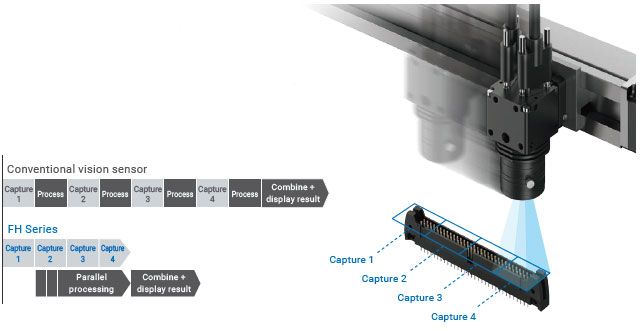
Camera Image Input HDR optimizes contrast
Camera Image Input HDR helps create optimized HDR images under variable ambient conditions. Once you specify the optimum area to capture on the image, the FH Series automatically adjusts the shutter speed while capturing images and combining the images.
Adjusts brightness to suit your specified area

Detects low-contrast defects in high-contrast mode

Parallel processing for different inspections
Multi-Line Random-Trigger inspects at up to four different timings
A single controller can perform inspections at different points at different timings.
Controllers installed for each process can be integrated into one, reducing initial costs and saving space.
Packaging process of pharmaceuticals
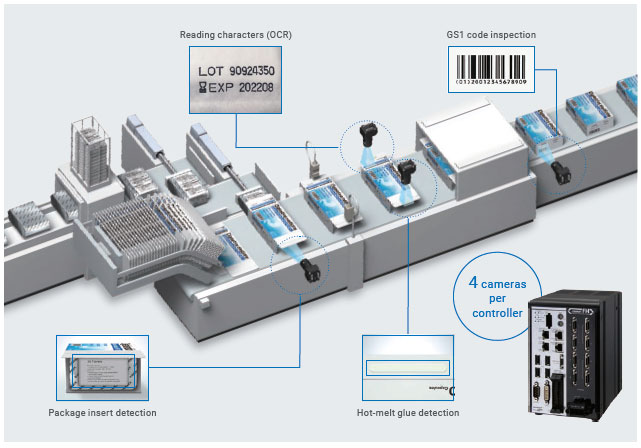
Contamination inspection of beverage containers
A single controller that can control each line saves initial costs and space.
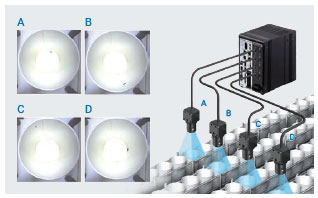
Appearance inspection of rechargeable battery cells
Four cameras can be connected to one controller, enabling simultaneous inspection of dents and scratches from four directions.
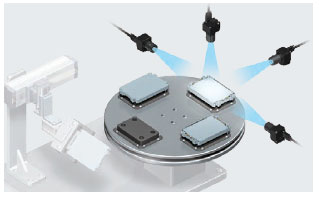
High-speed, high-precision positioning
Shape Search III is robust against shape variations
High-precision and robust positioning is possible even under the adverse conditions, such as changes in environments and materials.
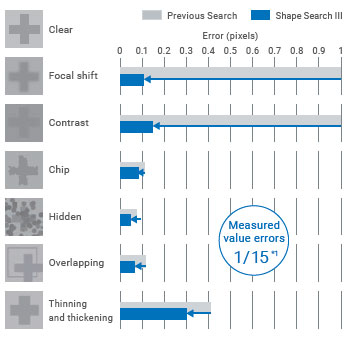
*1. The value measured under our specified conditions is provided for reference.
A 20.4 Mpix camera can search a positioning mark in as fast as 12 ms *2, and a 5 Mpix camera, widely used for alignment applications, in as fast as 2 ms.
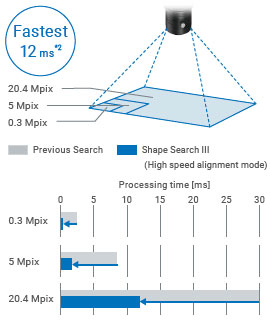
*2. The value measured under our specified conditions is provided for reference. 20.4 Mpix camera.
Circular Scan Edge Position accurately estimates the center and radius of a circle
The new algorithm accurately detects a whole circle from a part of the circle.
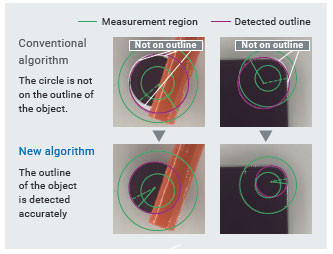
Scan Edge Position removes noise to detect edges
This algorithm accurately estimates lines even when the edges are unclear due to variations in objects or disturbance.
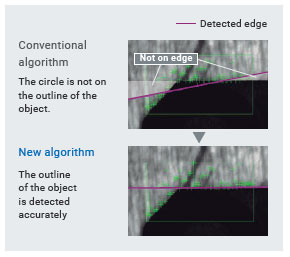
Stage Data calculates for various stages
The popular single axis + θ axis stages as well as UVW stages can be used. The use of the same axis for both handling and positioning simplifies machine configuration.
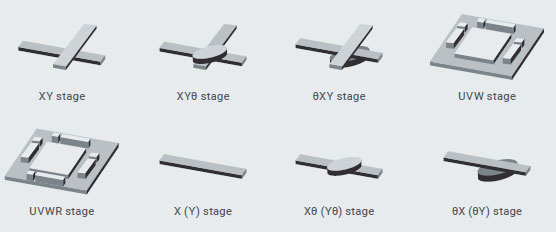
Robot Setting Tool simplifies connecting robots
Communication programs to connect robots from various vendors and FH flowcharts required for robot applications are provided free of charge. You can quickly set up robot vision applications.
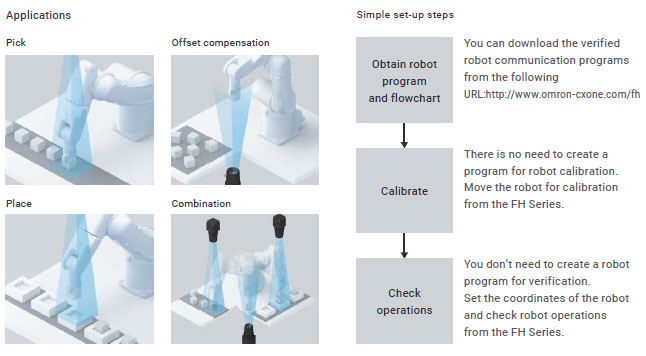
Unique identification and quality control
Unique ID associated with inspection image and result
The FH Series can associate a unique ID with the inspection image and result, and then output them to the host device.
You can immediately find required inspection images and quickly identify causes of fails.
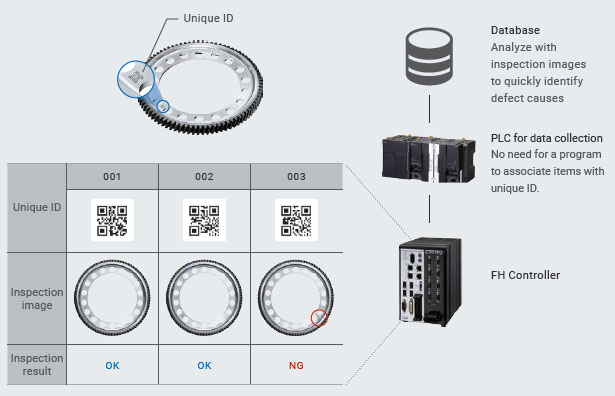
High-speed image storage
The amount of inspection image data required for defect cause analysis can be so large that conventional controllers are unable to store it given their storage time and capacity constraints.
The high-speed, large-capacity controller has USB 3.0 ports and the improved algorithm to compress image data at high speeds, enabling all images to be stored to meet increasing needs in quality control.
The times in the following figure provided for reference only and their accuracy cannot be guaranteed. They are measured under the following conditions:
• FH-5[]5[] Controller
• 5 Mpix monochrome images
• Size of converted JPEG file: 0.6 MB
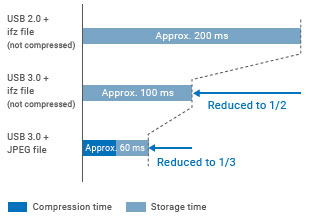
2D Code II provides powerful code reading
The FH Series incorporates a dedicated algorithm for reliable and fast 2D code reading even under variable ambient brightness or adverse conditions such as after processing or washing.
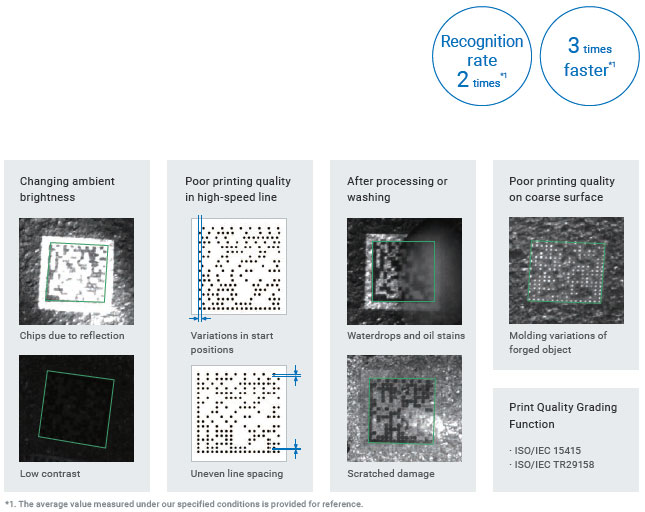
OCR reliably reads difficult-to-read characters
OCR can reliably read characters printed too close to each other or on curved surfaces. Also plus signs can be read.
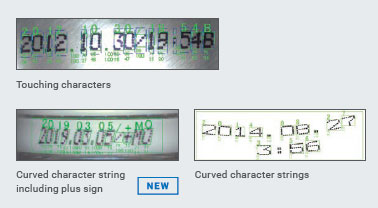
Character Inspection reads special fonts
Character Inspection recognizes special fonts and non-alphanumeric characters based on pattern search using the dictionary set up by the user.
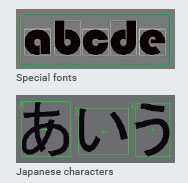
Design interface for quick setup
Integrated development environment Sysmac Studio
Sysmac Studio is a unique environment that integrates logic, motion and drives, robotics, safety, visualization, and information technologies in a single project, thus reducing the learning curve and the intra-operative software costs.
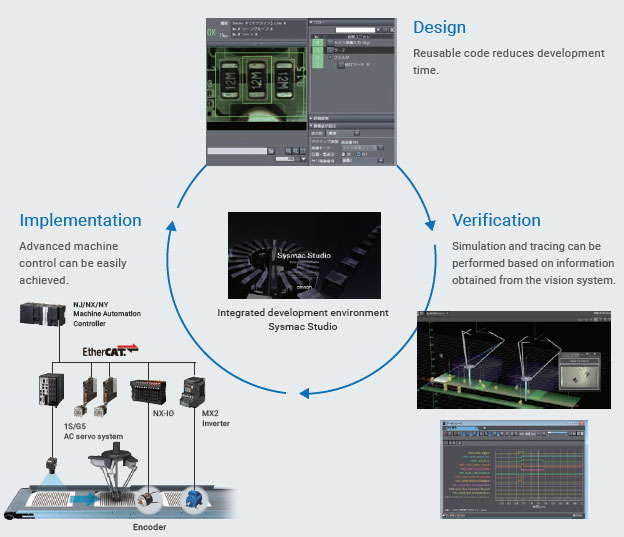
EtherCAT® for high-speed data transfer to control various devices
You can use EtherCAT® to connect NJ/NX Machine Automation Controllers and 1S/G5 AC Servo System to increase the control speed of everyday communications protocols from position detection to starting axis motion.

Total Design Management Editor simplifies complex processing design
This design interface includes pre-installed screens for all phases, from design through to setting and operation.
Just select processing items and determine the order to manage variables. Time-consuming calculations and inputs are no longer required.
Easy setting
All the common settings of multiple scenes can be made at once. Simplified inspection flowcharts reduce setting errors and prevent from forgetting to change settings.
Efficient setting
To inspect aligned parts, the FH Series can repeat the same measurements while shifting the measurement region within the same image. This reduces setting times.
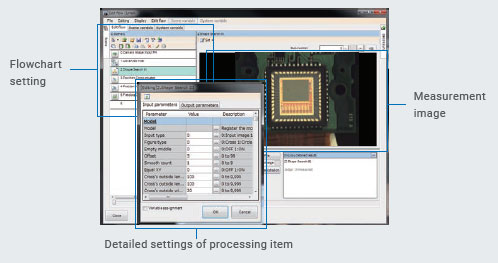
Customizable user interface simplifies operations at production sites
Showing only necessary screens for production makes the interface easier to use. Screen layout can be customized just by selecting and placing objects, without programming.
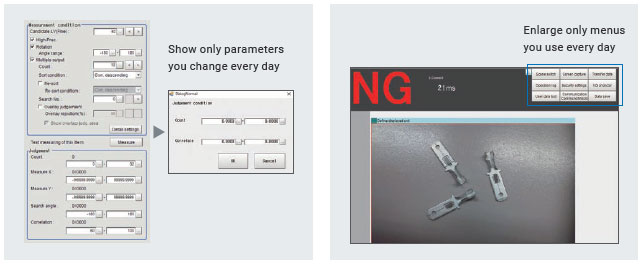
last update: March 1, 2024


